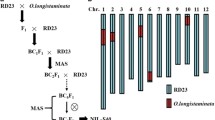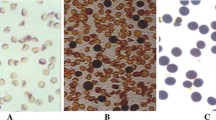Abstract
Exploiting heterosis using pollen control systems such as genic male sterility (GMS) can significantly improve the seed yield of sesame. In this study, we developed a novel GMS line (W1098A) by backcrossing and sib-mating the wild accession Yezhi2 (Sesamum mulayanum Nair, 2n = 26) plants with the cultivar Ezhi1 (S. indicum L., 2n = 26). The sterility of this line is mainly controlled by one dominant GMS gene (Ms). Cytological investigation showed that pollen abortion in W1098A plants began in pollen mother cells, continued throughout pollen development, and peaked at the late microspore stage. The abortion process was closely associated with the abnormal behaviour of the tapetum. We employed bulked segregation analysis to identify SSR markers linked to the Ms gene in a segregating population derived from sib-mating between the near-isogenic lines W1098A and W1098B. Among 1,500 SSR primer pairs screened against the sterile and fertile bulks of DNA, 13 markers were found to be linked to the Ms locus. The closest markers on both sides of Ms were SBM298 and GB50, at a respective genetic distance of 0.15 and 0.70 cM. These markers will be valuable for marker-aided breeding of GMS hybrids and map-based cloning of Ms.




Similar content being viewed by others
References
Anitha VY, Ganesan J (2000) Development of male sterility system in sesame (Sesamum indicum L.). Sesame Safflower Newsl 15:20–25
Bhayan J, Sarma MK (2003) Identification of heterotic crosses involving cytoplasmic genic male sterile lines in sesame (Sesamum indicum L.). Sesame Safflower Newsl 18:7–11
Biswas AK, Mitra AK (1999) Inter-specific hybridization in three species of sesamum. Indian J Genet Plant Breed 50:307–309
Budowski P, Markley KS (1951) The chemical and physiological properties of sesame oil. Chem Rev 48:125–151
Coulman KD, Liu Z, Hum WQ, Michaelides J, Thompson LU (2005) Whole sesame seed is as rich a source of mammalian lignan precursors as whole flaxseed. Nutr Cancer 52:156–165
Dabral KC, Mandloi KC (1974) A peculiar sterility in sesame (Sesamum indicum L.). JNKVV Res J Jabalpur 8:54–56
Dixit A, Jin MH, Chung JW, Yu JW, Chung HK, Yu JW, Chung HK, Ma KH, Park YJ, Cho EG (2005) Development of polymorphic microsatellite markers in sesame (Sesamum indicum L.). Mol Ecol Notes 5:736–738
Doyle JJ, Doyle JL (1987) A rapid DNA isolation procedure for small quantities of fresh leaf tissue. Phytochem Bull 19:11–15
Erbas M, Sekerci H, Gul S, Furat S, Yol E, Uzon B (2009) Changes in total antioxidant capacity of sesame (Sesamum indicum L.) by variety. Asian J Chem 21:5549–5555
Fu TD, Yang GS, Yang XN (1990) Studies on ‘three line’ Polima cytoplasmic male sterility developed in Brassica napus L. Plant Breed 104:115–120
Gao HS, Liu JR, Tu LC (1992) Cytological studies on the mechanism of abortion of microsporogenesis in nucleic male sterile (NMS) sesame (Sesamum indicumL.). Acta Agron Sin 18:425–428
Guo W, Miao HM, Zhang TD, Wei LB, Li C, Zhang HY (2014) Cytological observation of partial sterility of nucleic male sterile line ms86-1 in sesame (Sesamum indicum). Chin Bull Bot 49:87–97
Karatzi K, Stamatelopoulos K, Lykka M, Mantzouratou P, Skalidi S, Zakopoulos N (2013) Sesame oil consumption exerts a beneficial effect on endothelial function in hypertensive men. Eur J Prev Cardiol 20:202–208
Kavitha M, Ramalingam RS, Raveendran TS, Punitha D (2000) Cytoplasmic-genic male sterile lines in sesame: Effect of environmental factors. Crop Res 19:162–164
Kumar LS, Abraham A (1941) A cytological study of sterility in sesame. Indian J Genet Plant Breed 1:41–60
Kumar LS, Rao DS (1945) Inheritance of sterility in Sesamum indicum L. Indian J Genet Plant Breed 1:58–59
Li YD, Chen QM (1998) Studies on induced mutation and preliminary genetics of male sterile mutants in sesame (Sesamum indicum L.). Chin J Oil Crop Sci 20:24–27
Li SL, Qian YX, Wu ZH (1985) Genetic study on genic male sterility and its utilization in Brassica napus L. Acta Agric Shanghai 1:1–12
Li SL, Zhou ZJ, Zhou XR (1995) Three-line method of genetic male sterility for hybrid seed production in Brassica napus L. Acta Agric Shanghai 11:21–26
Li SG, Zhou KD, Zhu LH (1999) Molecular mapping and genetic analysis of dominant themo-sensitive genic male sterile in rice. Chin Sci Bull 44:955–958
Li SQ, Yang DC, Zhu YG (2007) Characterization and use of male sterility in hybrid rice breeding. J Integr Plant Biol 49:791–804
Lin ZX, He DH, Zhang XL, Nie YC, Guo XP, Feng CD, Stewart JM (2005) Linkage map construction and mapping QTL for cotton fiber quality using SRAP, SSR and RAPD. Plant Breed 124:180–187
Liu HY, Yang MM, Wu K, Zhou XA, Zhao YZ (2013) Development, inheritance and breeding potential of a recessive genic male sterile line D248A in Sesame (Sesamum indicum L.). SpringerPlus 2:268–276
Lu GY, Zhang XK, Li GY, Chen Y, Zheng PY (2012) Breeding of high yield, double low and disease resistant rapeseed cultivars by population improvement. Chin J Oil Crops Sci 34:575–581
Ma H (2005) Molecular genetic analyses of microsporogenesis and microgametogenesis in flowering plants. Annu Rev Plant Biol 56:393–434
Ma JH, Wei HL, Liu J, Song MZ, Pang CY, Wang L, Zhang WX, Fan SL, Yu SX (2013) Selection and characterization of a novel photoperiod-sensitive male sterile line in upland cotton. J Integr Plant Biol 55:608–618
Malaguti G, Mazzani B (1958) Cases of sterility in sesame. Agron Trop Venezuela 8:63–65
Mathias R (1985) A new dominant gene for male sterility in rapeseed, Brassica napus L. Z Pflanzenzuchtung 94:170–173
Michelmore RW, Paran I, Kesseli RV (1991) Identification of markers linked to disease-resistance genes by bulked segregant analysis: a rapid method to detect markers in specific genomic regions by using segregating populations. Proc Natl Acad Sci USA 88:9828–9832
Osman HE, Yermanos DM (1982) Genetic male sterility in sesame: reproductive characteristics and possible use in hybrid seed production. Crop Sci 22:492–498
Pal BP (1945) Studies in hybrid vigor of sesame (Sesamum indicum L.). Indian J Genet Plant Breed 5:106–121
Periasamy S, Hsu DZ, Chang PC, Liu MY (2014) Sesame oil attenuates nutritional fibrosingsteatohepatitis by modulating matrix metalloproteinases-2, 9 and PPAR-gamma. J Nutr Biochem 25:337–344
Prabakaran AJ (1998) Cytoplasmic male sterility in sesame from the species cross, Sesameum malabaircum × S. indicum: II. Microsporogensis and outcrossing. In: Martínez JF (ed) Sesame safflower Newsl. CSIC Press, Córdoba, pp 7–12
Shi YL, Zhao S, Yao JL (2009) Premature tapetum degeneration: a major cause of abortive pollen development in photoperiod sensitive genic male sterility in rice. J Integr Plant Biol 51:774–781
Stam P (1993) Construction of integrated genetic linkage maps by means of a new computer package, join map. Plant J 3:739–744
Taylor PE, Glover JA, Lavithis M, Craig S, Singh MB, Knot RB, Dennis ES, Chaudhury AM (1998) Genetic control of male fertility in Arabidopsis thaliana: structural analyses of postmeiotic developmental mutants. Planta 205:492–505
Tu LC, Liang XY, Wang WQ, Zheng YZ, Liu JR (1995) Studies on the genetic male sterile in sesame. Acta Agric Boreali-Sin 10:34–39
Uzun B, Lee D, Donini P, Cagirgan MI (2003) Identification of a molecular marker linked to the closed capsule mutant trait in sesame using AFLP. Plant Breed 122:95–97
Uzun B, Ozbas MO, Canci H, Cagirgan MI (2004) Heterosis for agronomic traits in sesame hybrids of cultivars × closed capsule mutants. Acta Agr Scand B-S P 54:108–112
Uzun B, Arslan Ç, Furat S (2008) Variation in fatty acid compositions, oil content and oil yield in a germplasm collection of sesame (Sesamum indicum L.). J Am Oil Chem Soc 85:1135–1142
Wang Q, Wang BC (2002) Study on the mechanism of sesame male sterile and its hereditary. J Anhui Agric Sci 30:837–838
Wang DJ, Guo AG, Li DR, Tian JH, Huang F, Sun GL (2007) Cytological and molecular characterization of a novel monogenic dominant GMS in Brassica napus L. Plant Cell Rep 26:571–579
Wang LH, Yu S, Tong CB, Zhao YZ, Liu Y, Song C, Zhang YX, Zhang XD, Wang Y, Hua W, Li DH, Li D, Li F, Yu JY, Xu CY, Han XL, Huang SM, Tai SS, Wang JY, Xu X, Li YR, Liu SY, Varshney RK, Wang J, Zhang XR (2014) Genome sequencing of the high oil crops sesame provides insight into oil biosynthesis. Genome Biol. doi:10.1186/gb-2014-15-2-r39
Wanjari KB, Patil AN, Patel MC, Manjaya JG (2000) Male sterility derived from Cajanussericeus × Cajanuscajan: confusion of cytoplasmic male-sterility with dominant genic male-sterility. Euphytica 115:59–64
Wei LB, Zhang HY, Zheng YZ, Miao HM, Zhang TZ, Guo WZ (2009) A genetic linkage map construction for sesame (Sesamum indicum L.). Genes Genom 31:199–208
Yang M, Huang FH (2009) Situation, problem, development trend and suggestion of sesame industry in China. Chin Oils Fats 34:7–12
Yang GS, Fu TD, Ma CZ, Yang XN (1996) Establishment of a random mating population of Polima cytoplasmic male sterility restorers in Brasica napus L. J Huazhong Agric Univ 15:316–321
Yang XL, Zhang HY, Guo WZ, Zheng YZ, Miao HM, Wei LB, Zhang TZ (2008) Ultrastructure in microspore abortion of genic male sterile line in sesame (Sesamum indicum L.). Acta Agron Sin 34:1894–1900
Zhang TD, Zhang HY, Zheng YZ, Wei SL, Mei HX (2005) A review of heterosis and seed production techniques in sesame. Crops 5:64–67
Zhang HY, Wei LB, Miao HM, Zhang TD, Wang CY (2012) Development and validation of genic-SSR markers in sesame by RNA-seq. BMC Genom 13:316–326
Zhang HY, Miao HM, Wei LB, Li C, Zhao RH, Wang CY (2013) Genetic analysis and QTL mapping of seed coat color in sesame (Sesamum indicum L.). PLoS One 8:e63898
Zhang YX, Wang LH, Xin HG, Li DH, Ma CX, Ding X, Hong WG, Zhang XR (2013) Construction of a high-density genetic map for sesame based on large scale marker development by specific length amplified fragment (SLAF) sequencing. BMC Plant Biol 13:141–152
Zhao YZ, Liu HY (2008) The breeding and key cultivation points of hybrid sesame variety Zhongzhiza No.1. World Agric 11:147–150
Zhao YZ, Yang MM, Wu K, Liu HY, Wu JS, Liu KD (2013) Characterization and genetic mapping of a novel recessive genic male sterile gene in sesame (Sesamum indicum L.). Mol Breed 32:901–908
Zheng YZ, Zhang HY, Mei HX, Zhang TD, Wei SL (2003) Advances in Chinese hybrid sesame research. J Henan Agric Sci 11:17–19
Acknowledgments
This research was funded by National Natural Science Foundation of China (31101180) and China’s National Agricultural Research System (CARS-15).
Author information
Authors and Affiliations
Corresponding author
Electronic supplementary material
Below is the link to the electronic supplementary material.
Rights and permissions
About this article
Cite this article
Liu, H., Zhou, X., Wu, K. et al. Inheritance and molecular mapping of a novel dominant genic male-sterile gene in Sesamum indicum L.. Mol Breeding 35, 9 (2015). https://doi.org/10.1007/s11032-015-0189-5
Received:
Accepted:
Published:
DOI: https://doi.org/10.1007/s11032-015-0189-5




